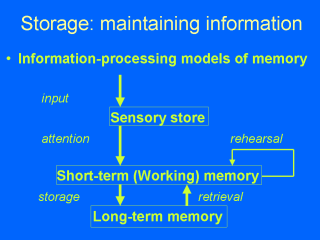| front |1 |2 |3 |4 |5 |6 |7 |8 |9 |10 |11 |12 |13 |review |
 |
Established models of memory
storage propose three stages. The sensory buffer (mentioned previously), the short-term or
working memory (STM) and the long-term memory (LTM). STM is a limited
capacity store that maintains unrehearsed information for 20-30 seconds. The STM can be
“refreshed” by rehearsal (try this by learning a new telephone number), repetitively
verbalizing or thinking about the information. Working memory consists of three
components: a rehearsal (articulatory) loop, a visuo-spatial sketchpad (VSS) and an
executive control system. The rehearsal loop enables refreshment of STM information. The
VSS enables holding and manipulation of spatial data, while the executive manages the
information needed for reasoning, which is brought into the STM for processing. STM data
is replaced by a process of displacement, new data displacing existing data. STM has a
capacity for 7+2 items, but this limit can be overcome by “chunking” data into
units which then become the items. LTM is an unlimited capacity store that can hold information over long periods of time. Is LTM permanent? Is forgetting a retrieval problem? That is, the information is still in there, but you can’t locate it, or do some memory traces fade and are lost? Much research supports the permanent store hypothesis. But, there is some evidence that recall might be socially dependent. That is, when memories for an event witnessed by several people are “recalled”, what is “recalled” is a reconstruction with contributions from each witness to make a re-construction of the event. Similarly, evidence indicates that a lot of recall for events is inaccurately recalled. That is, there is a lot of creativity in the recall process. So memory is not very much like a tape recorder or computer disk. Summary: STM has three components- AL, VSS, CE; LTM is very capacious. |